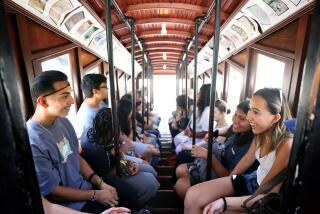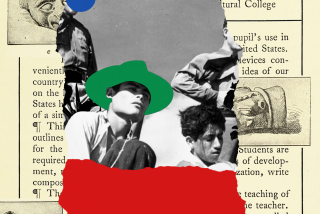Students’ Delve Into Past, but Look to Future
- Share via
Faces of Japanese American children held in World War II-era internment camps peered from behind red borders on Alice Hunt’s history project sitting in the Chaparral Middle School library.
Across the room, a small TV screen built into a red, white and blue display ran highlights of Ronald Reagan’s presidency. At another display, colored patches of fabric showed the symbols Nazis once pinned on the clothes of people they hated.
The projects, created by 32 Chaparral students, were part of a national “History Day” competition designed to encourage in-depth research into historical topics. After weeks of study, design and construction, the young scholars faced a panel of judges Tuesday.
By day’s end, the judges selected four projects to go to the next level of competition--a statewide contest held in Sacramento in May.
Hunt and Zach Ramirez, who researched the legacy of labor activist Cesar Chavez, won for best individual projects. Peter Kauffmann and Derek Yuan took top group project honors for their work on the forced relocation of the Cherokee Nation. Another group--including J.P. Collins, David Graham, Matt Gray, Dustin Liang and Paul Tondreau--won second place for their project on Reagan.
The students were all members of Fran Pavley’s eighth-grade history class, the only Ventura County class to participate in the event, Pavley said.
Students were given a theme--triumph and tragedy in history--and told to include in their research as many sources and points of view as possible. The choice of topic was up to them.
Hunt, 14, picked Japanese American internment during World War II in part because many of the camps were located in California. Her research took her to the Japanese American National Museum in Los Angeles, where she met a docent who had lived in the camps.
Like Hunt, many of the students chose emotionally charged topics. Erika Saldivar, 13, examined whether early Christian missions in California helped Native Americans or hurt them by stripping away their culture. Most of her display consisted of quotes from Native Americans and Europeans, including Father Junipero Serra.
“In some quotes, he sounds like a saint,” she said. “In others, you can’t believe it’s the same person. You can’t believe someone could dislike someone else that much, calling them savages.”
More to Read
Sign up for Essential California
The most important California stories and recommendations in your inbox every morning.
You may occasionally receive promotional content from the Los Angeles Times.










